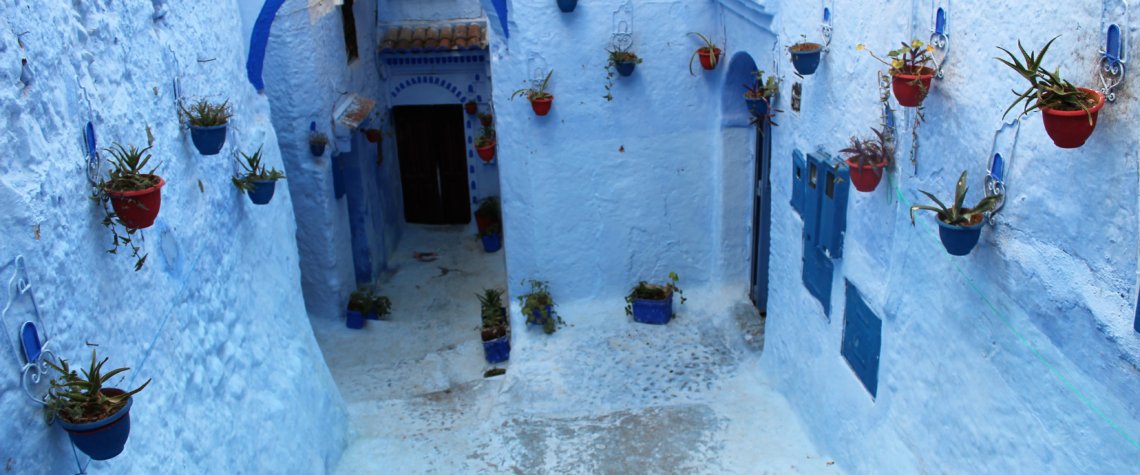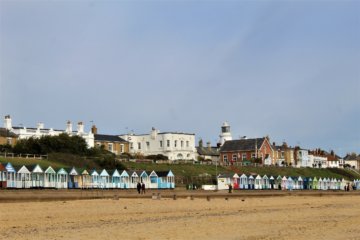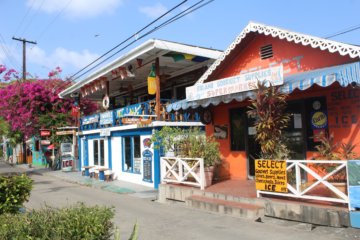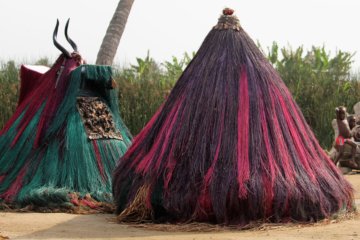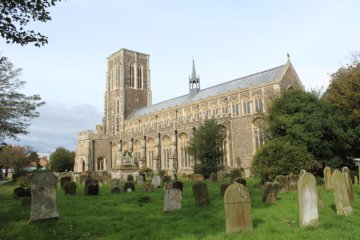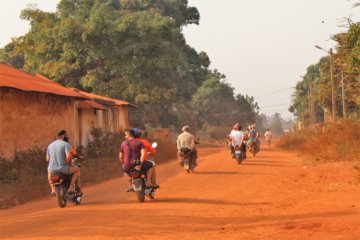Welcome to my Morocco travel guide! In this article, you will find all the information you will need if you are planning a trip to this incredible North African nation.
In this article
First Thoughts
Morocco is an amazingly diverse country. From the epic snow-capped peaks of the High Atlas, through the ancient medinas of Fez and Marrakech, to the undulating dunes of the Sahara Desert, Morocco has something for everyone. It’s not a place just to go and lie on a beach for two weeks (although some people do). It’s a place for wandering and exploring. It’s an assault on the senses. There is so much history to discover. There are so many dishes to savour. There are so many friendly people to meet and stories to hear. It’s a country that you will want (no, need!) to return to time and again.
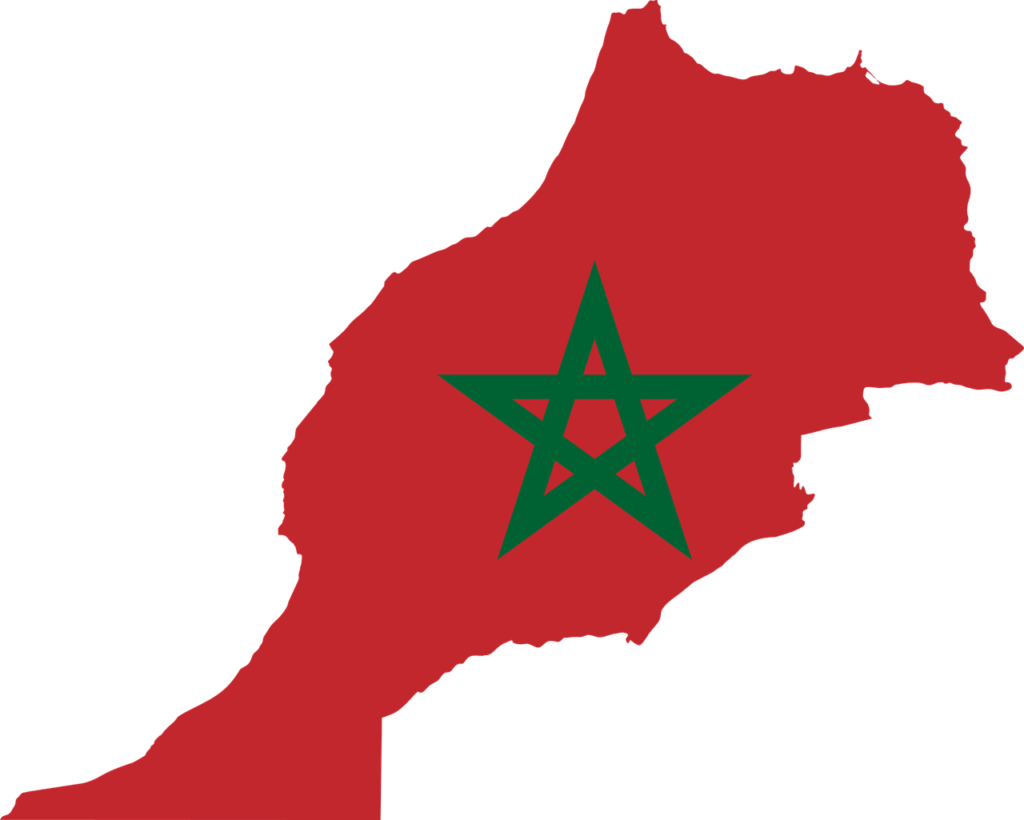
Essential Information About Morocco
- Area – 710,850 km2
- Population – about 37 million
- Language – Arabic and Berber are the official languages. The local languages Darija and Hassaniya are also spoken as are French, English, and Spanish.
- Capital – Rabat
- Currency – Moroccan dirham (MAD)
- Time zone – GMT
- Telephone – the country code for Morocco is +212
- Electrical socket – Morocco uses two plug types. Type C has two round pins and type E has two round pins and a hole for the socket’s male earthing pin. Morocco operates on a 220V supply. Why not bring a universal travel adapter with you.
- Visas – tourists generally don’t need a visa for stays of up to 90 days. Check for up-to-date information before you travel.
Local laws
Morocco is no stricter than many other countries, but it has laws which may be different from your home nation. Familiarise yourself with them and respect them. As anywhere throughout the world, ignorance of the law is no defence!
Morocco is a Muslim country which follows Islamic laws and customs. Make sure your behaviour doesn’t offend, especially during the holy month of Ramadan or if you intend to visit religious areas. You should respect local traditions, customs, laws and religions at all times and make sure you dress appropriately.
Avoid public displays of affection, particularly outside the main tourist areas and close to religious sites.
Sexual relations outside marriage are punishable by law. It’s not uncommon for hotels to ask couples to show evidence of marriage at the time of check-in, and if such evidence is not available, to insist on separate rooms.
Homosexuality is a criminal offence in Morocco. Be sensitive to local laws and customs and avoid public displays of affection. Complaints can lead to prosecution.
Alcohol is served in licensed hotels, bars and in tourist areas. However, drinking alcohol in the street and anywhere other than a licensed restaurant or bar isn’t allowed you could be arrested.
Possessing, using or dealing in illegal drugs is a serious offence and can result in a lengthy prison sentence and/or a heavy fine.
It is against the law to carry bibles in Arabic, to attempt to distribute any non-Muslim or evangelical literature or to be involved in any such activity.
Avoid taking any photographs near sensitive political or military sites.
You’ll need permission from the authorities to fly a drone. Contact the Moroccan Civil Aviation Authority for more information about the rules. In 2016, a number of British nationals were fined and had their passports confiscated for flying drones without permission.
It’s illegal to possess pornographic material.
Health and Safety in Morocco
Health
It’s important to check the latest health advice issued by your government before you travel. In the UK, this is available from the National Travel Health Network and Centre (NaTHNaC). You should also make an appointment with your GP or travel clinic about six weeks before you set off in order to find out about the latest vaccination requirements.
There are currently no vaccination certificate requirements for Morocco, but all travellers should be immunised against hepatitis A, tetanus, and typhoid as a matter of course. Those in high-risk groups should also protect themselves from hepatitis B, rabies, and tuberculosis.
Malaria is not an issue in Morocco, but insect or tick bites can cause irritation and infections of the skin and they can also spread certain diseases like leishmaniasis, Rift Valley fever and West Nile virus. There are no vaccinations or medications to prevent these diseases so the best line of defence is not to get bitten!
- Use a DEET based insect repellent
- Wear mosquito repellent bracelets
- Burn mosquito coils
- Cover up, especially at dawn and dusk
- Eat Marmite! This is Mark’s preferred method!
If you need medical assistance whilst in Morocco, dial 15 for an ambulance.
It should go without saying that you must never travel without comprehensive travel insurance.
Safety
The vast majority of tourist visits to Morocco are incident-free. However, it is sensible to consider the following:
Political Situation
Protests can occur at short notice across the country. They are mostly peaceful but there have been isolated incidents of violence. You should follow local and international developments in the media and avoid political gatherings and demonstrations. If you do inadvertently get caught up in such an event, always follow the instructions given by the local security authorities.
Crime
Incidents of violent crime occasionally occur. There have been isolated incidents involving the use of knives against tourists.
Petty crime is common, especially in tourist areas like the medina quarter of towns and cities and on beaches. These offences include pick-pocketing, bag snatching and drive-by motorcycle theft of visible jewellery and handbags.
Take the same precautions as you would take anywhere:
- Don’t carry large amounts of cash
- Don’t wear ostentatious jewellery
- Use a hotel safe where possible to store valuables and passports
- Wear a money belt
- Don’t walk in deserted areas, even during daylight
- Take care when withdrawing cash from an ATM
Driving
This information is from the UK government website:
You need a 1968 International Driving Permit (IDP) to drive in Morocco. For UK travellers, you can get these over the counter in most post offices. You can’t get them in Morocco, so if you plan to hire a car, make sure you get one before you go.
Morocco has a poor road safety record. In 2018, 3,485 people were killed and approximately 100,000 injured in traffic accidents. The road fatality rate is approximately 9 times higher than in the UK.
Drive carefully, especially in poor weather conditions, on secondary routes and on mountain roads. Driving at night can be particularly hazardous due to poor lighting. Lorries and trucks may be overloaded and you should take extra care around them. It’s common to encounter pedestrians crossing motorways. You should take extra care when overtaking, particularly where there is no hard shoulder. Leave plenty of time to reach your destination and respect speed limits.
If you’re involved in a road accident, you should complete a ‘Constat Amiable’ form, to be signed by both parties. Blank forms are available on arrival at Tangier port from the insurance company booths and from tobacconists in all cities. If the accident results in a fatality and the Moroccan authorities consider you responsible, you may be detained pending a trial hearing.
If you enter Morocco with a vehicle, the registration number will be recorded. If you’re not in possession of the same vehicle when leaving Morocco, you’ll be refused exit and detained. You’ll need to provide evidence of adequate motor insurance. You should always carry your insurance, licence and registration documents with you.
Terrorism
Visitors should check with their government’s most up-to-date travel guidelines, but shouldn’t be put off travelling to Morocco.
There is an increased threat linked to the number of Moroccans sympathetic or belonging to Daesh (formerly referred to as ISIL) and other extremist groups. Authorities regularly report the disruption of terrorist cells across the country. Crowded areas, government installations, transportation networks, businesses with Western interests, and areas where foreign nationals and tourists are known to gather may be at higher risk of attack. You should be vigilant in these areas and follow any specific advice of the local security authorities.
Emergency numbers
- Fire and ambulance – 15
- Police – 19 in major cities, 177 for the gendarmerie outside cities
Festivals and Celebrations in Morocco
Public Holidays
- 1st January – New Year’s Day
- 11th January – Independence Manifesto (commemorates the publication in Fez of the Moroccan nationalist manifesto for independence)
- 1st May – Labour Day
- 30th July – Feast of the Throne (commemorates King Mohammed VI’s accession)
- 14th August – Allegiance of Oued Eddahab (celebrates the ‘return to the fatherland’ of the Oued Eddahab region in the far south, a territory once claimed by Mauritania)
- 20th August – Anniversary of the King’s and People’s Revolution (commemorates the exile of Mohammed V by the French in 1953)
- 21st August – Young People’s Day (celebrates the king’s birthday)
- 6th November – Anniversary of the Green March (commemorates a strategic mass demonstration in November 1975, coordinated by the Moroccan government, to force Spain to hand over the disputed, autonomous semi-metropolitan province of Spanish Sahara to Morocco)
- 18th November – Independence Day (commemorates independence from France)
Major Islamic Holidays in Morocco
Islamic holidays are tied to the lunar calendar, so the dates change each year.
- Moulid an-Nabi – celebrates the birth of the prophet Mohammed. Children are given presents on this day.
- Eid al-Fitr – the Feast of the Breaking of the Fast marks the end of Ramadan. The four-day celebration begins with a meal of spicy lentil soup, dates and honey cakes. All businesses and public transport shut down during this family holiday.
- Eid al Adha – this three-day Feast of the Sacrifice honours Ibrahim’s willingness to sacrifice his son as a sign of his obedience to Allah. Families traditionally sacrifice a sheep during this holiday.
Best Time to Go to Morocco
Morocco is a great year-round destination, but the best time to visit is during spring (mid-March to May) or autumn (September to October). This way, you avoid the extremes of very cold temperatures in the mountains in winter and scorching hot days in the desert in summer.
What to Pack for Morocco
No Morocco travel guide would be complete without mention of what you should take with you. Where you are going in Morocco and at what time of year will determine what you need to pack. Layers are always best so that you can add more or take some off as you change altitude. Be aware that even in the desert temperatures can fall dramatically at night.
Women, especially when travelling alone, may receive unwanted attention from men. To minimise hassle, you should choose loose-fitting clothing which covers the arms, legs and chest. You will feel more comfortable, too!
READ MY COMPLETE PACKING LIST FOR MOROCCO
Where to Stay in Morocco
Morocco has a wide range of hotels, guesthouses and self-catering apartments to suit all pockets.
Make sure you spend at least one night in a riad. Many of these traditional Moroccan houses or palaces with interior gardens or courtyards have been restored to their former glory and converted into luxurious accommodation. You will get a real sense of what life was like for a wealthy Moroccan merchant and his family as you sip mint tea whilst relaxing on sumptuous cushions arranged around an ornate fountain. There are many thousands of riads in Morocco, particularly in Marrakech and Essaouira.
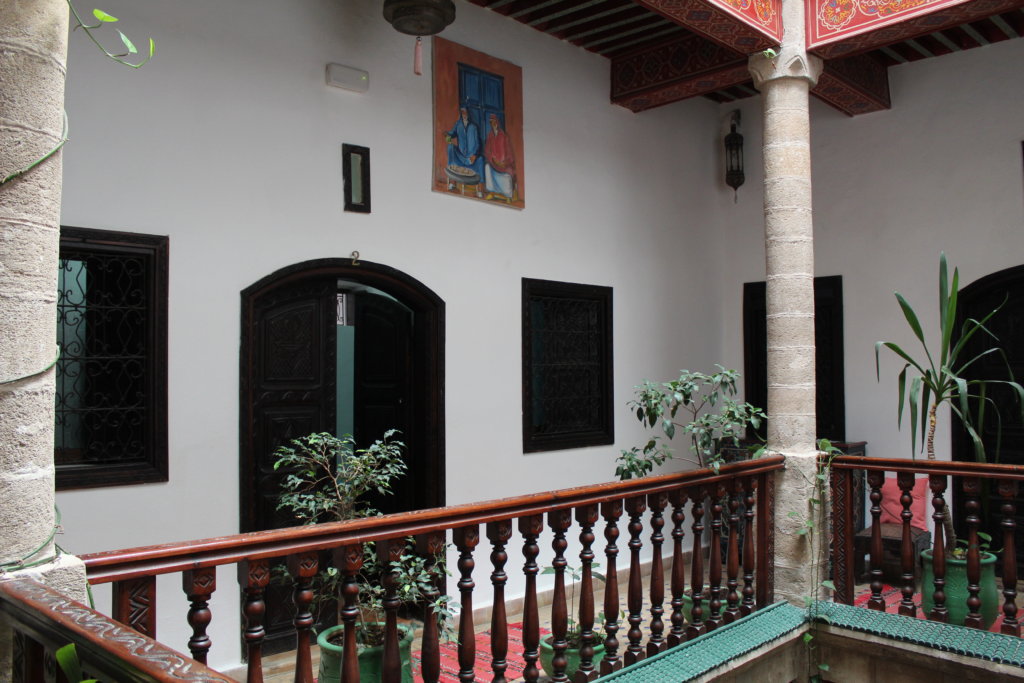
If you are travelling in the High Atlas Mountains, be sure to stay with a family in a gîte d’étape. These provide basic accommodation similar to a youth hostel with thin mattresses on the floor of a shared dormitory, but don’t be put off! Berber people are famous for their hospitality and good cooking. You will be welcomed into the family home and fed extremely well!
Another unique place to stay in Morocco is under canvas in the Sahara. This is an unforgettable experience which you can read more about below.
I recommend that you search for suitable accommodation on Booking.com:
Booking.com
What to Eat in Morocco
The food in Morocco is flavoursome and varied. It will surely be a highlight of any trip to this incredible country.
Moroccan cookery is influenced by the nation’s interactions with other cultures over hundreds of years. You will taste flavours of Berber, Arabic, Andalusian, European, Sub-Saharan, and Mediterranean traditions, all blended into one delicious cuisine.
My Morocco travel guide continues with a description of some of the dishes you will enjoy for each meal.
Breakfast
A Moroccan breakfast typically revolves around bread. Freshly baked rolls and flatbreads are served warm with a tantalising array of colourful accompaniments. These include fruity extra-virgin olive oil, a variety of plump olives, runny honey, apricot jam, delicious dates, clarified butter, soft goats’ cheese, and spicy chutneys. Eggs are also commonplace, either boiled or fried, both with runny yolks perfect for dipping your bread in to!
One of our favourite breakfasts on our trip around Morocco, though, was Berber omelette. Onions, tomatoes and peppers are fried with spices in a tagine over an open fire. Beaten eggs are added. The lid is then put on and the whole thing is allowed to cook gently until the eggs are set. The resulting dish is absolutely delicious and will certainly set you up for a day full of sightseeing or trekking in the mountains!
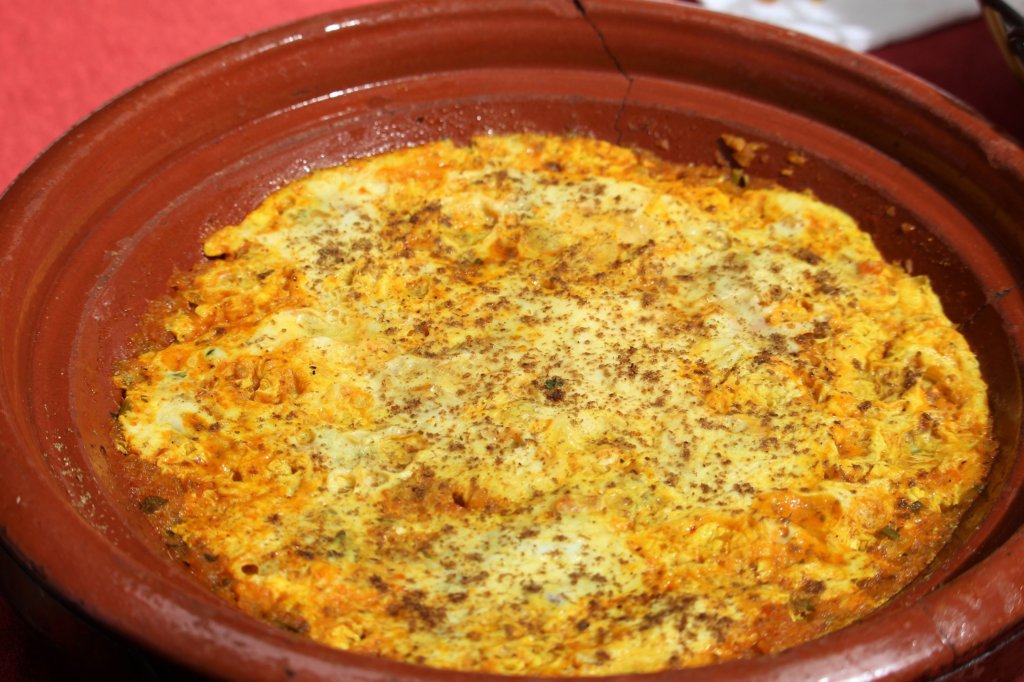
Mezze
Moroccan meals often start with mezze, a selection of vibrant salads and tasty bites. Taking inspiration from Middle Eastern cuisine, mezze in Morocco might include olives, hummus, zaalouk ( a cooked aubergine and tomato salad), crudités, warm flatbreads, chickpeas, and lamb meatballs. Whatever you have, it’s a very social way to begin a meal with everyone eating from the same plate or bowl.
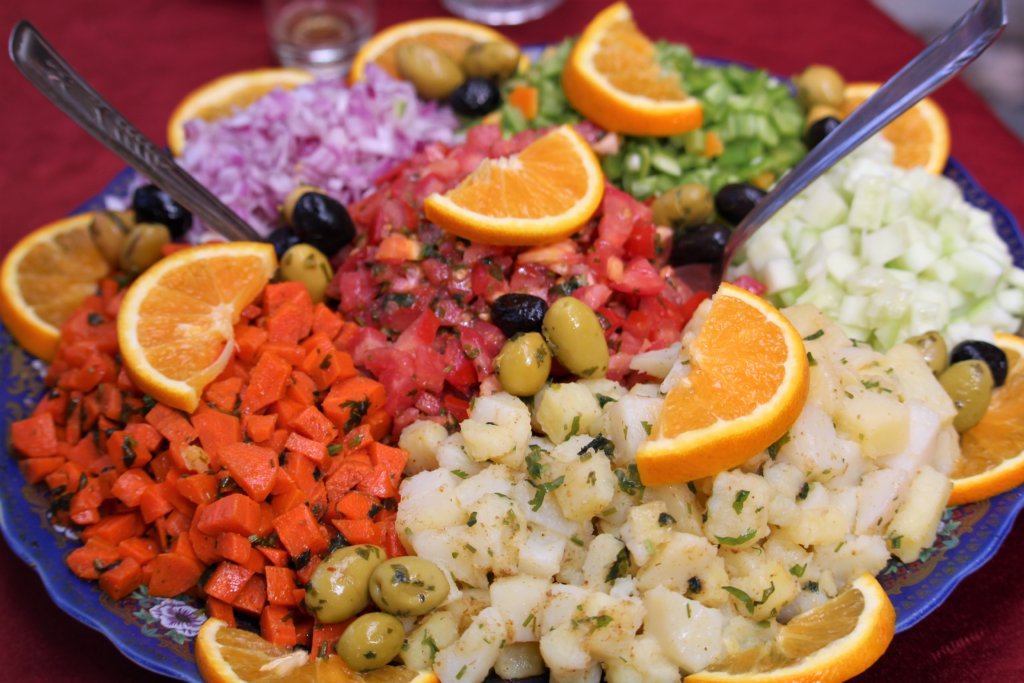
Main Dishes
When you think of Moroccan food, the first dish that probably comes to mind is tagine. Tagine is the name of the iconic conical cooking pot and also the name of the dish that is cooked in it. To make it, you layer sliced vegetables, herbs, spices, and meat (chicken, beef, or lamb) along with oil and water. As the mixture cooks, a stew-like consistency develops, making a rich, flavorful sauce that is often scooped up with bread.
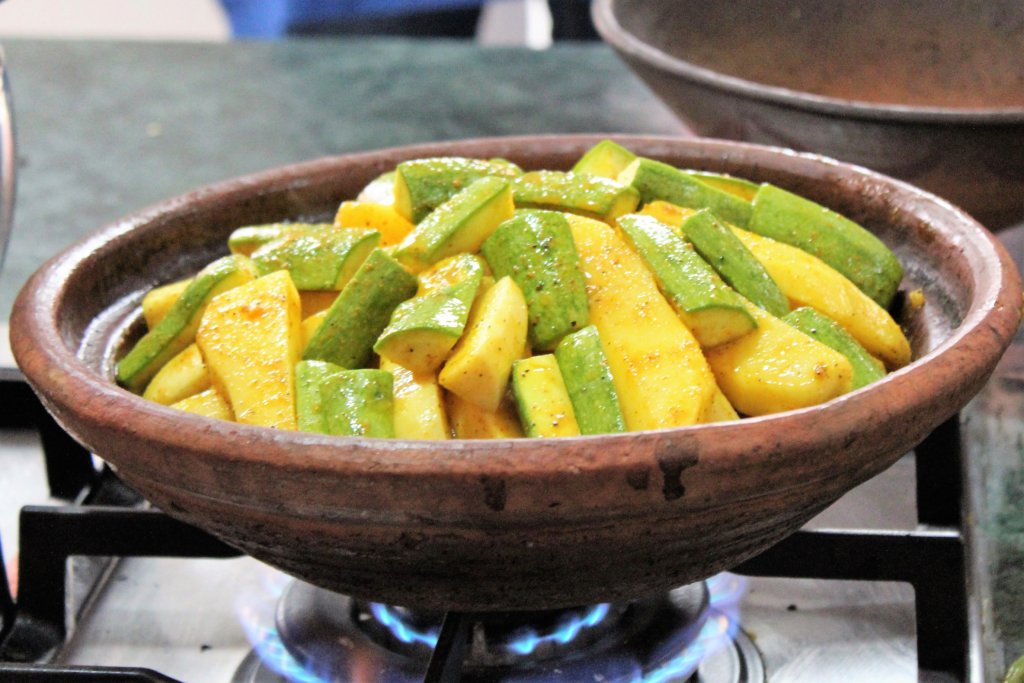
Tagine is invariably served with couscous, the Berber staple of semolina grains. Unlike the dried variety rehydrated with boiling water we are used to in our kitchens, Moroccan couscous is prepared by hand with loving care. The process is much more involved and takes much longer than we would expect.
Other popular main dishes include tangia, a meat stew traditionally cooked in a clay pot in the neighbourhood hammam, and fish chermoula.
Moroccans love combining meat and fruit in their main dishes. Examples include rabbit with prunes, lamb with dried apricots, beef with dates, and, my favourite, chicken with preserved lemons and olives.
There are many regional specialities, too. We particularly enjoyed trying pastilla in Fez. This sweet and savoury pie is traditionally made with chicken or pigeon wrapped in crisp layers of filo pastry and sprinkled with icing sugar. The camel burgers we had in Meknès were another revelation!
Desserts
Typically, Moroccan people have a very sweet tooth! Sticky, syrupy baklava flavoured with honey, dates, figs, rosewater, and pistachio is extremely popular, as are desserts made from oranges, the national fruit.
Street Food
Street food is everywhere in Morocco. The finest examples are found in Jemaa el-Fnaa, Marrakech’s main square, where a food market consisting of over 100 stalls opens up every evening.
Typical dishes include harira (spicy tomato and lentil soup), snail broth, lamb brochettes, and merguez (chilli beef or lamb sausages) served in soft bread rolls – Moroccan hotdogs! Grilled sardines are also found everywhere, as is maakouda. These delicious golden fritters are made from mashed or grated potatoes, garlic, cumin, onions and coriander, which are then dipped in beaten eggs before frying.
The Middle Eastern classic, shawarma, is also very popular in Morocco. Choose from lamb or chicken. It will come in a wrap with a selection of toppings which might include hummus, tahini, chilli sauce, pickled vegetables or salad.
One of my favourite Moroccan street foods is msemmen, a cross between a crêpe and a soft flatbread. It is made from working and folding thin layers of dough rather than using a batter. It’s then fried on a hotplate until golden brown. The resulting pancake can either be stuffed with fillings like kefta and onions or spicy herbs and vegetables, or topped with butter, honey, or even cheese.
There are plenty of sweet street foods, too. Sfenj are light fluffy deep-fried doughnuts served coated in sugar or honey and often bought by workers on their way home in the afternoon. They are the perfect stop-gap between lunch and dinner! Don’t miss out on trying chebakia, a local Moroccan pastry shaped to look like a rose, deep-fried and then dunked in honey flavoured with rosewater.
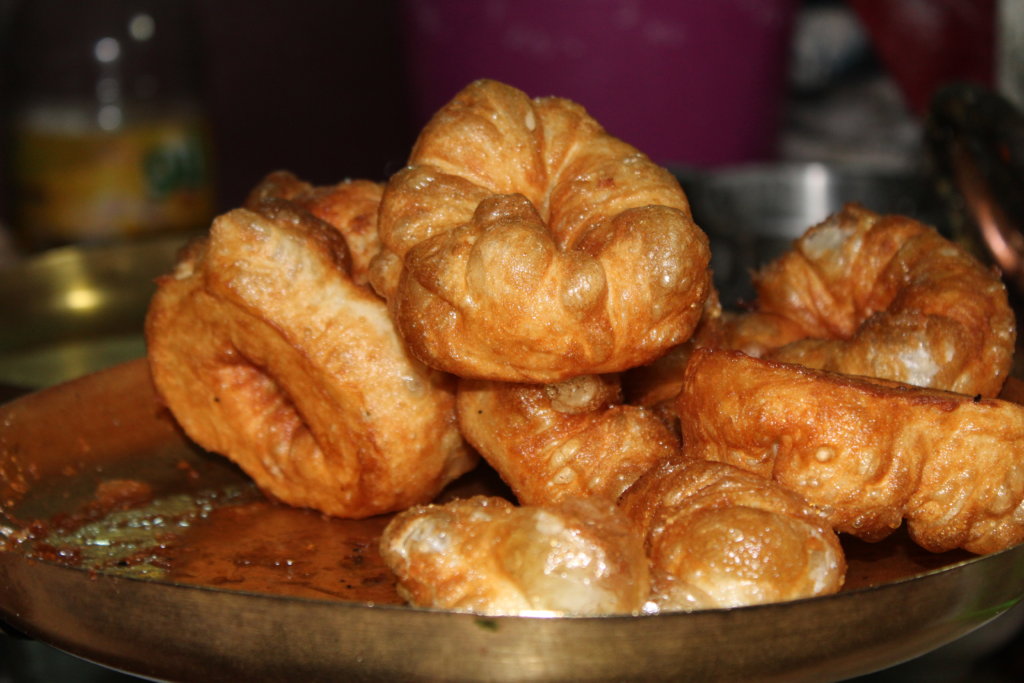
READ MY COMPLETE GUIDE TO MOROCCAN FOOD
What to Drink in Morocco
Alcohol
Despite the fact that alcohol is forbidden in Isalm and Morocco is a mainly Muslim country, the sale and consumption of alcohol is not banned. It is perfectly possible to drink alcohol in bars, restaurants, and hotels, particularly in tourist areas. You should respect local sensibilities, though, and not consume alcohol in public. In more ‘off-the-beaten-track’ places, alcohol will be harder to come by. Don’t try and flout local customs. Simply refrain until you are in a more touristy place!
Mint Tea
Mint tea, also known as Moroccan whisky, is ubiquitous in Morocco. It is made from gunpowder green tea flavoured with fresh mint leaves and sweetened with copious amounts of sugar. Locals drink it at any time of day. There are rituals associated with making and serving mint tea, as demonstrated in this video.
We enjoyed mint tea many times during our trip around Morocco, most notably in a family home in M’Hamid when our guide, Hamid, showed us the correct way to make it.
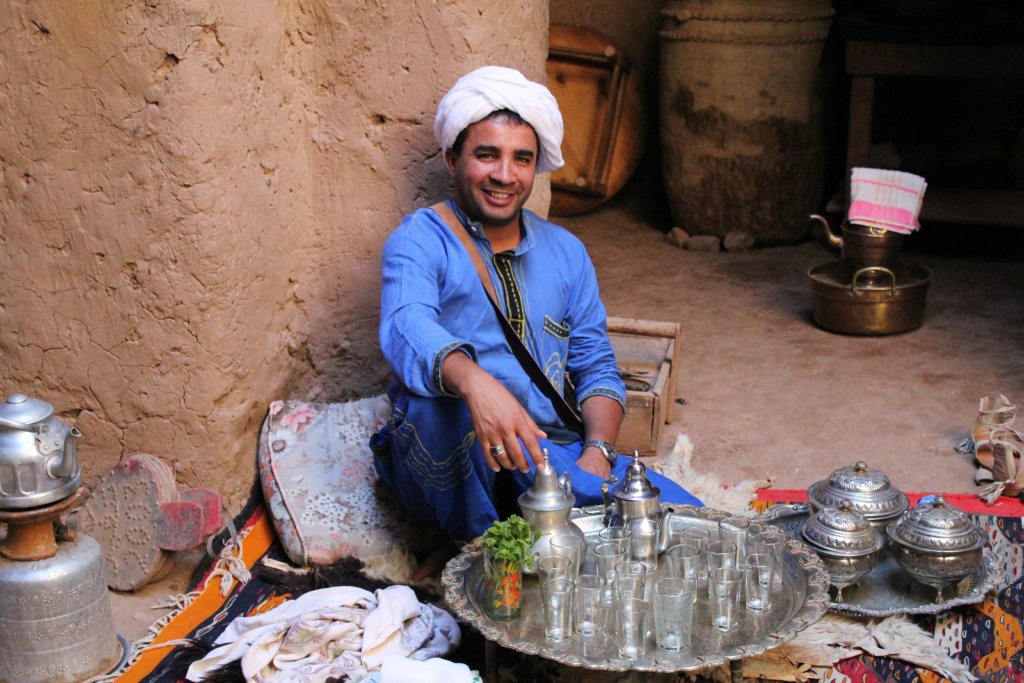
Coffee
Milkshakes
Milkshakes are popular in Morocco, particularly one made by whizzing together almonds, milk, dates, and a splash of orange flower water. Other flavours include avocado, mango, and strawberry.
Other Soft Drinks
Bottled water, sugar cane juice, fresh fruit juices (especially pomegranate), and proprietory soft drinks like Coca Cola, Fanta, and Sprite are widely available in Morocco.
Best Things to Do in Morocco
My Morocco travel guide continues with a round-up of the best things to do when you visit the country.
Spend a Night in the Sahara Desert
One of the most memorable things to do in Morocco is to spend a night ‘glamping’ in the Sahara! Semi-permanent camps have been set up where you can enjoy delicious meals and the experience of sleeping under canvas or, if you prefer, directly under stars. Your stay will usually include watching the sunset from the top of a dune, getting up very early to see the sunrise, and if you’re lucky, being entertained with Berber singing and dancing around the campfire.
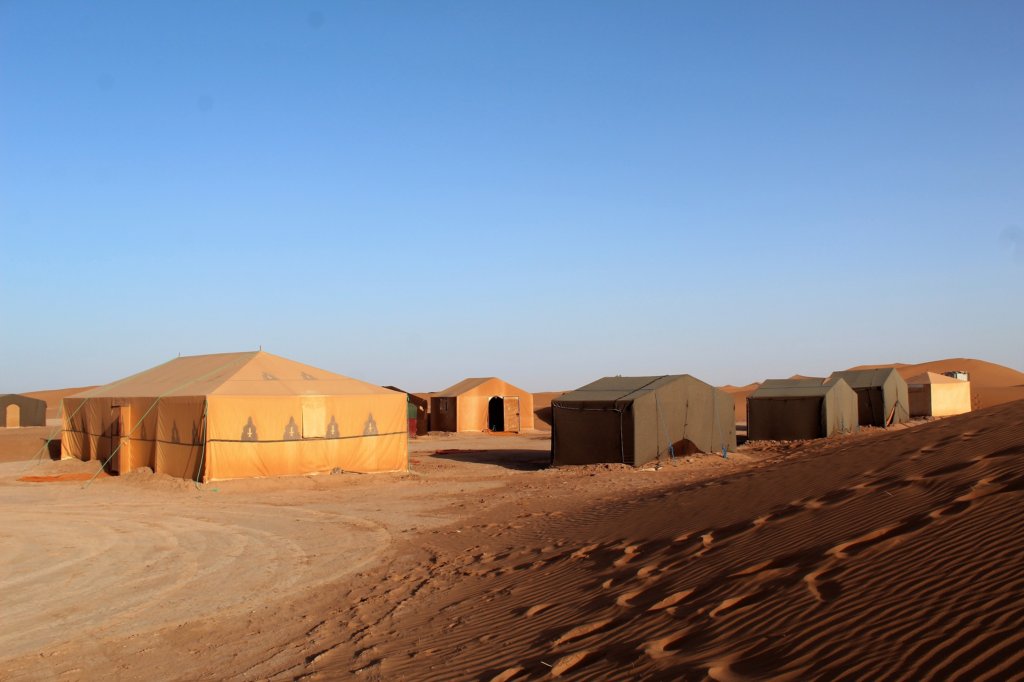
CLICK HERE FOR MORE ABOUT MOROCCO DESERT TOURS
Explore Casablanca with a Local Guide
I have talked many times about how Mark and I like to book a tour with a local guide whenever we visit a new city. It’s the best way we know to get under the skin of a place. We always discover things we would never have found by ourselves.
Casablanca was no exception. From visiting the impressive Hassan II Mosque, to wandering the lanes of the old medina, to sampling luscious olives, refreshing mint tea, and sweet almond pastries, our Urban Adventures tour ticked all the boxes.
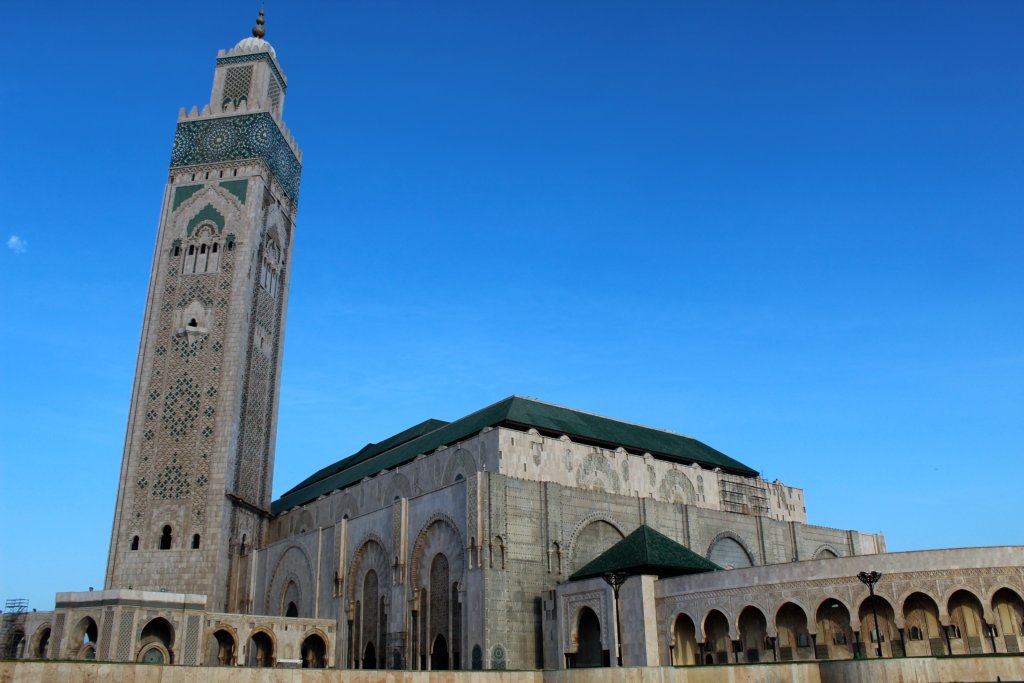
CLICK HERE TO READ MY REVIEW OF OUR CASABLANCA TOUR
Enjoy Mint Tea on a Food Tour of Marrakech
As I said above, mint tea is everywhere in Morocco and it’s important that you experience it with all the associated rituals. The best way to do this is as part of a food tour of Marrakech. As well as the tea, you will get to try sfenj, delicious bread straight from the oven, plump olives, tanjia, sweet cookies, and many other treats.
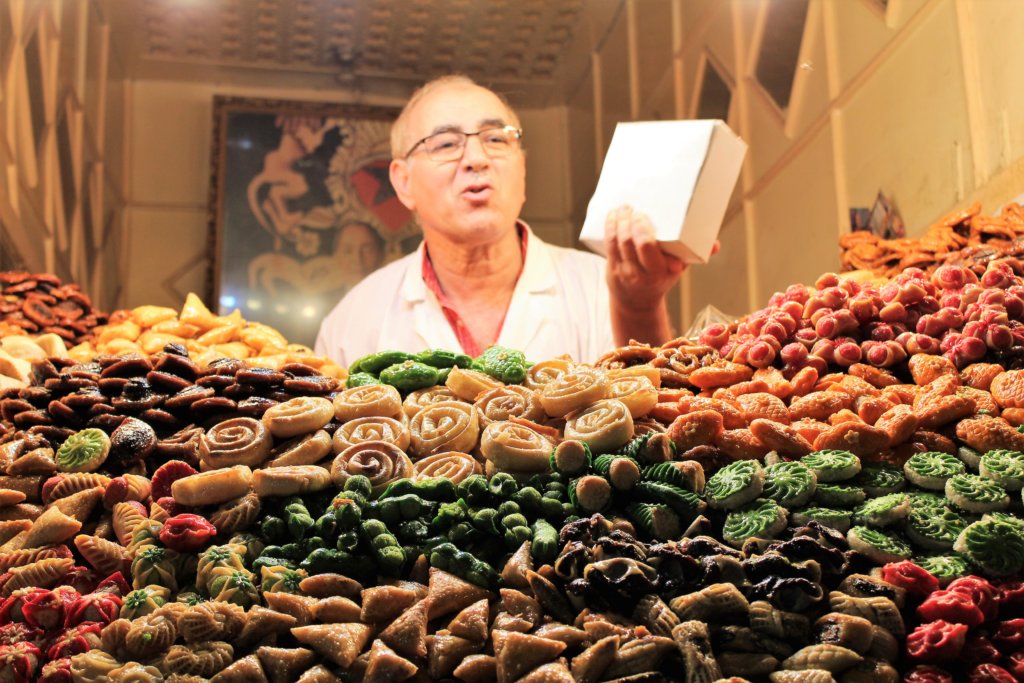
READ MY FULL REVIEW OF OUR TASTES OF MARRAKECH TOUR
Listen to the Call to Prayer at Sunset in Moulay Idriss
The holy city of Moulay Idriss was closed completely to non-Muslims until 1912 and it wasn’t until 2005 that they were allowed to stay overnight, so it still feels like a real privilege to be there. Whether you are religious or not, in the same way that Jerusalem or Rome affects you, so you feel a certain spirituality in the air at Moulay Idriss. It’s a very calming, peaceful place, a feeling which is only intensified by the sung call to prayer which fills the air five times a day.
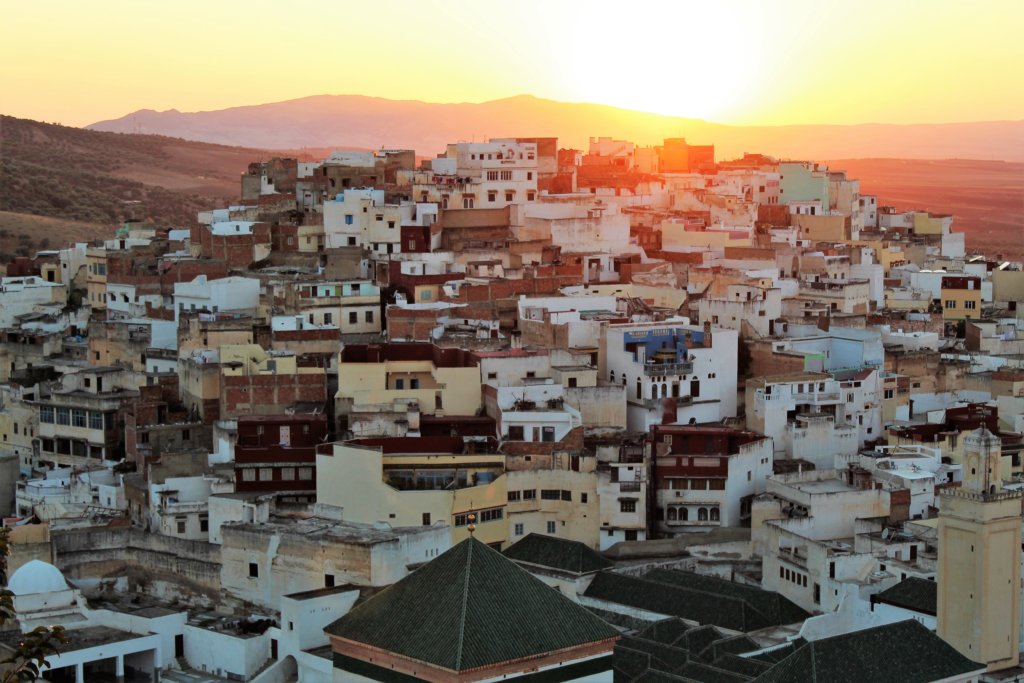
Read all about our stay in Moulay Idriss here.
Look Out for Goats Climbing Argan Trees
‘Goats climbing argan trees’ sounds like the title of a comedy sketch, but it is, in fact, one of the iconic sights of Morocco. The goats climb the trees to feed on the fruit of the argan tree. Later, the nuts that they excrete are collected and precious argan oil is extracted. This video explains the process:
Watch Street Theatre in Djemaa el-Fnaa in Marrakech
The main square in Marrakech, Djemaa el-Fnaa, has to be one of the largest, most chaotic, most colourful public spaces in the world. It is an assault on the senses. You can shop here, eat and drink here, and, most importantly, be entertained by jugglers, clowns, dancers, singers, musicians, and magicians. There are still snake charmers and monkey handlers in the square. My advice would be to steer well clear of these. The fewer tourists who engage with them, the sooner they will be a thing of the past on Moroccan streets.
Djemaa el-Fnaa is an experience not to be missed as you can see in this video.
READ ABOUT THE BEST THINGS TO DO IN MARRAKECH
Eat Camel Burgers in Meknès
With apologies to vegetarians, trying camel burgers in the medina in Meknès is a must-do activity in Morocco! The city itself has an interesting history, making it well worth a stop on any tour around the country. Once you’re there, you have to sample the camel burgers in the narrow, smoke-filled alleys of the medina!
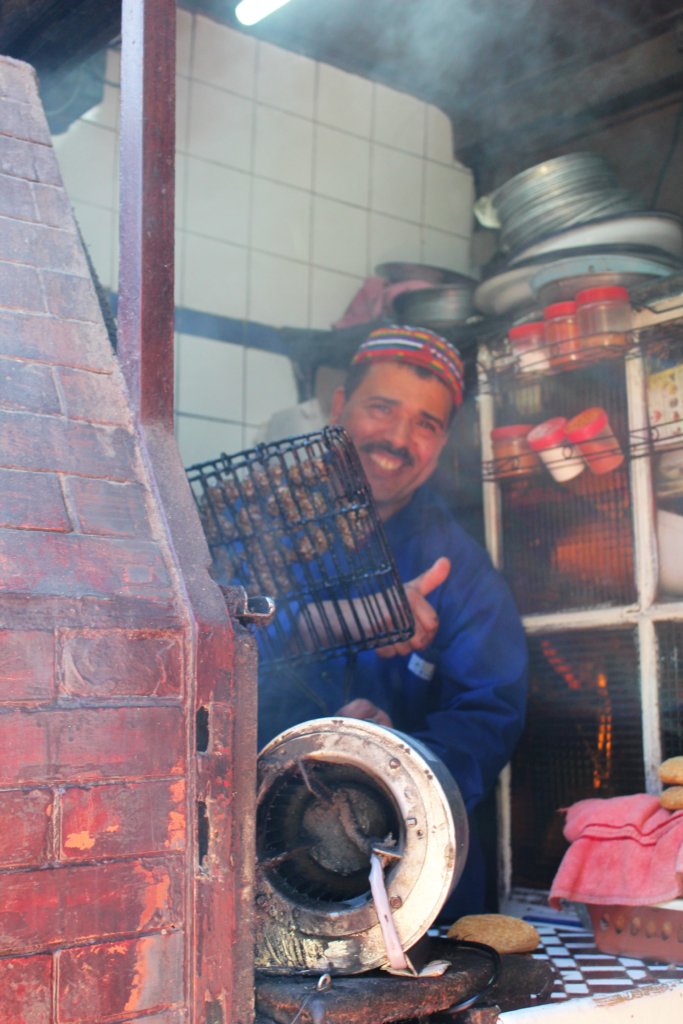
CLICK HERE FOR REASONS TO VISIT MEKNES
Lose Yourself in the Alleyways of Fez Medina
Fez has the oldest and largest medina in Morocco. You can easily spend a day meandering through the alleyways, soaking up the atmosphere as you peer through half-open doors wondering at the lives going on behind them. Your imagination will be fired up by the tantalising aromas, chaotic sounds, and colourful sights. Don’t worry about getting lost – it’s part of the experience! There’s no need to be overly afraid. Take the same precautions with your belongings and with your personal safety as you would anywhere else and just enjoy it!!
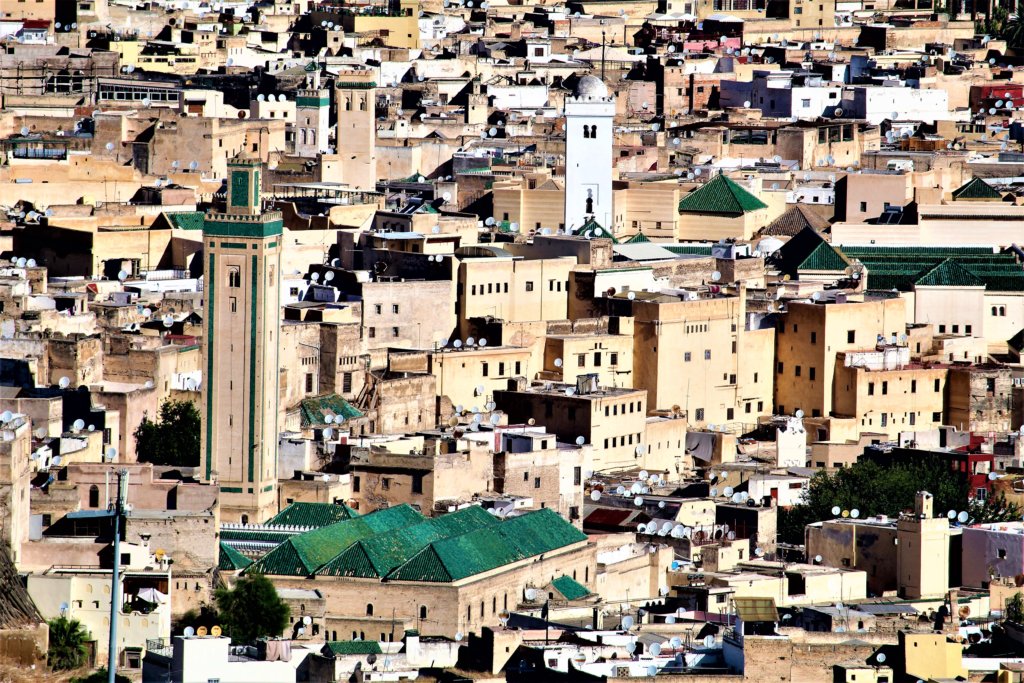
READ MY ARTICLE ON THE BEST THINGS TO DO IN FEZ
Hike in the Atlas Mountains
When you’ve had enough of bustling busy cities, why not escape for a day or two to the High Atlas region? Here, it will be cooler, the air will be clearer, and you can enjoy some unparalleled Berber hospitality. Go hiking, imagine you’re Russell Crowe as you visit the set of Gladiators, and marvel at the stunning kasbah at Aït Benhaddou.
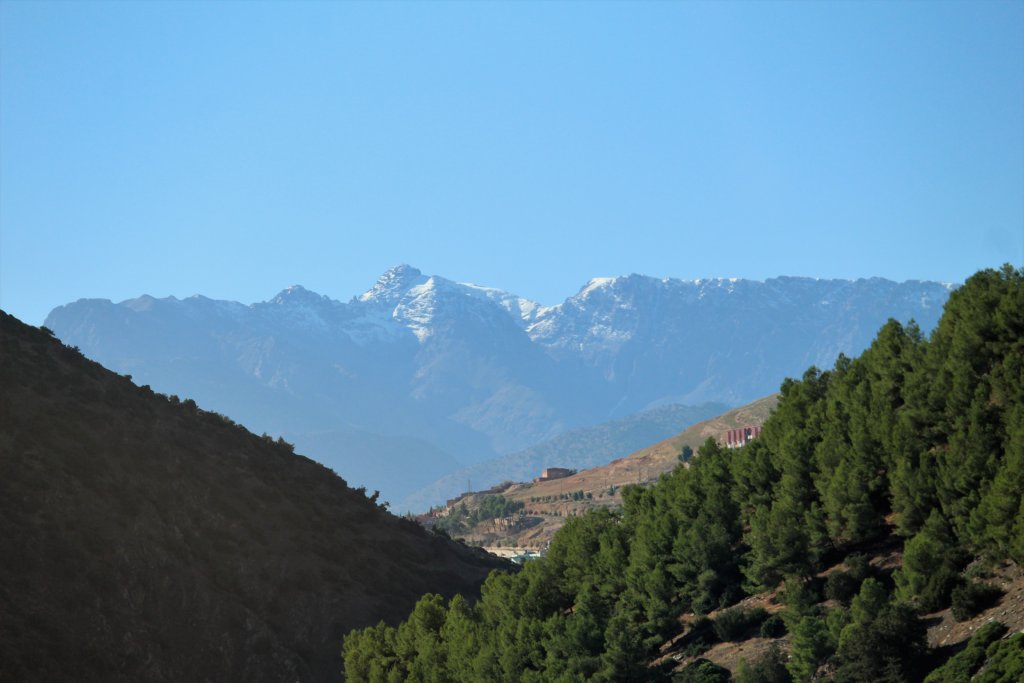
READ MY ARTICLE ON THE HIGH ATLAS MOUNTAINS
Learn How to Cook the Perfect Tagine
One of the best things to do when you visit a country for the first time is to take a cookery class and learn how to prepare one of the national dishes. We did just this in Marrakech. The class we took at Café Clock was incredible! We shopped for ingredients in the local souk and then learned how to make a cooked salad, a vegetable tagine, a lamb tanjia, and some delicious date pastries.
You can read my full review of the class (including details on how to book) here.
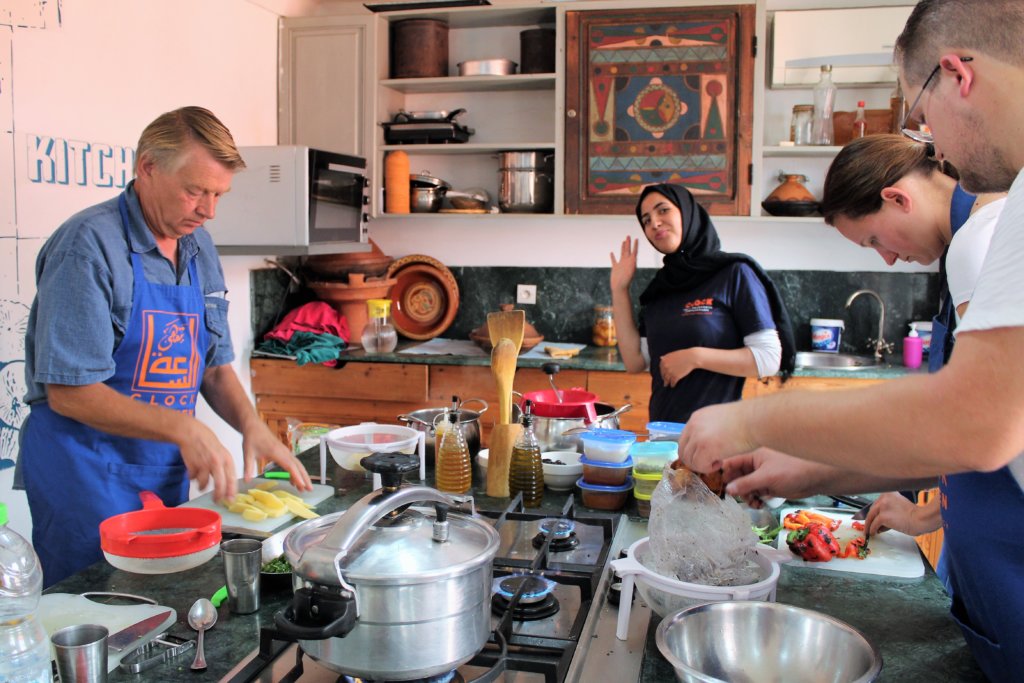
Take a Thousand Photos in Chefchaouen
Any visit to Morocco has to include a few days in the famous blue city, Chefchaouen. It’s a photographer’s dream with eye-catching photo opportunities around every corner. Wander around, chat with friendly locals, eat some amazing food, and haggle over a handwoven carpet!
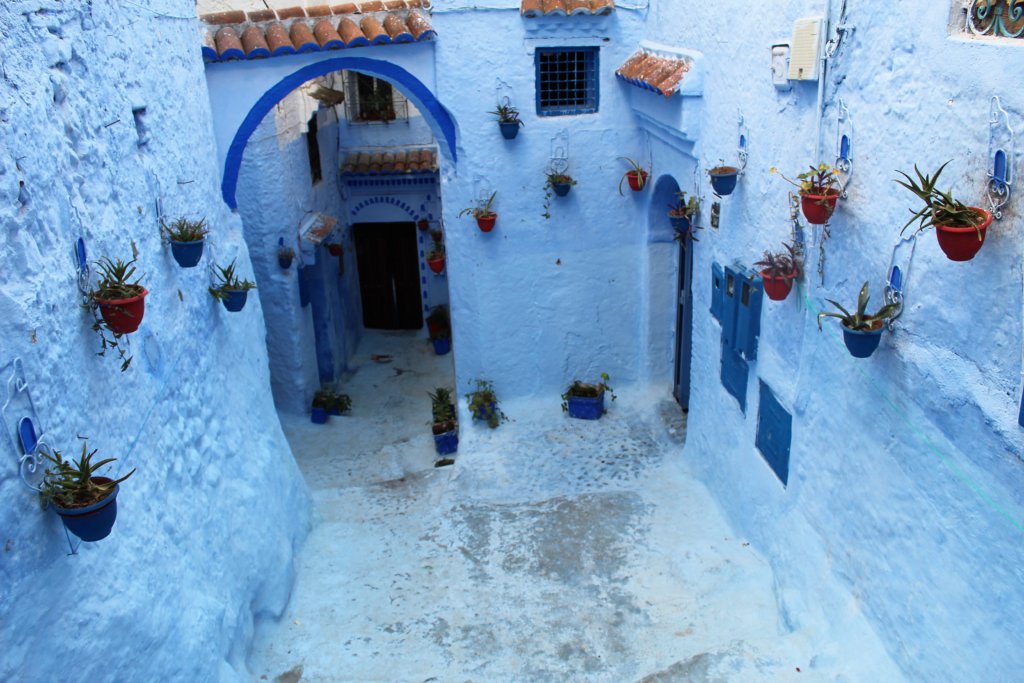
Some more photos of this beautiful town:
READ MY ARTICLE ABOUT CHEFCHAOUEN
Drive Through the Drâa Valley
The Drâa Valley is known as the date basket of Morocco. 18 varieties are grown here. Lush oases and verdant date palm plantations can be seen either side of the road as you drive the 190km from Ouarzazate, through Agdz and Zagora, to M’Hamid. The scenery is beautiful and there are plenty of places en route to stock up with supplies or to enjoy a delicious lunch.
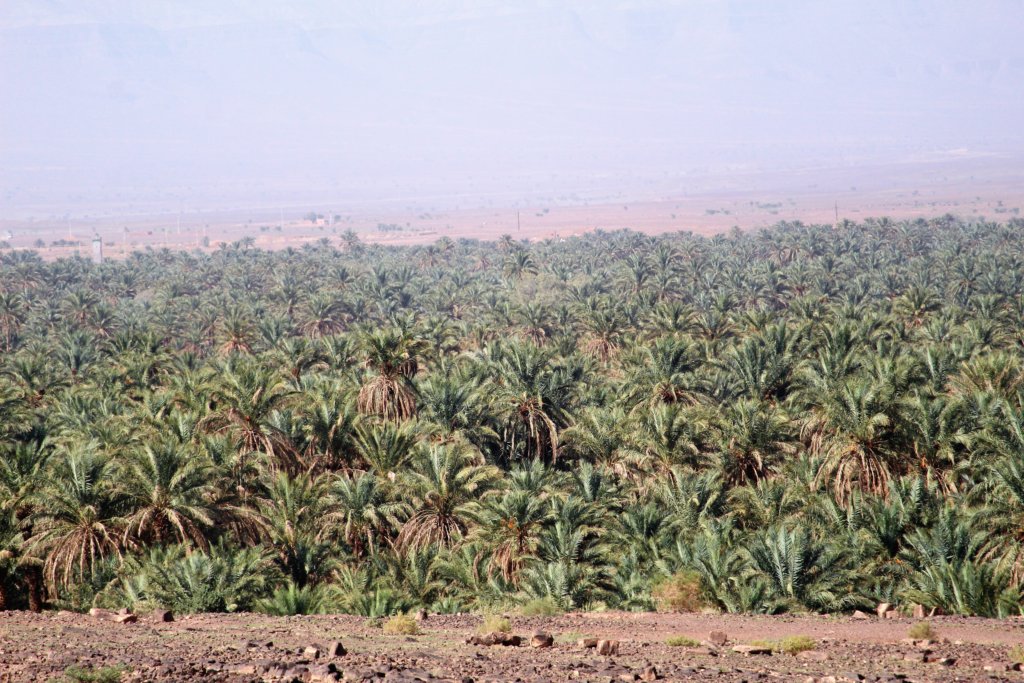
Stay with a Local Family
There is nothing like staying with a local family for learning about the culture, lifestyle, and cuisine of a place. During our tour around Morocco, we stayed with a family in Moulay Idriss and learned how to cook couscous properly. We also enjoyed an amazing dinner in the home of our driver’s sister in Tangier and had lunch in a family home in M’Hamid. These were amongst the top highlights of our four-week trip.
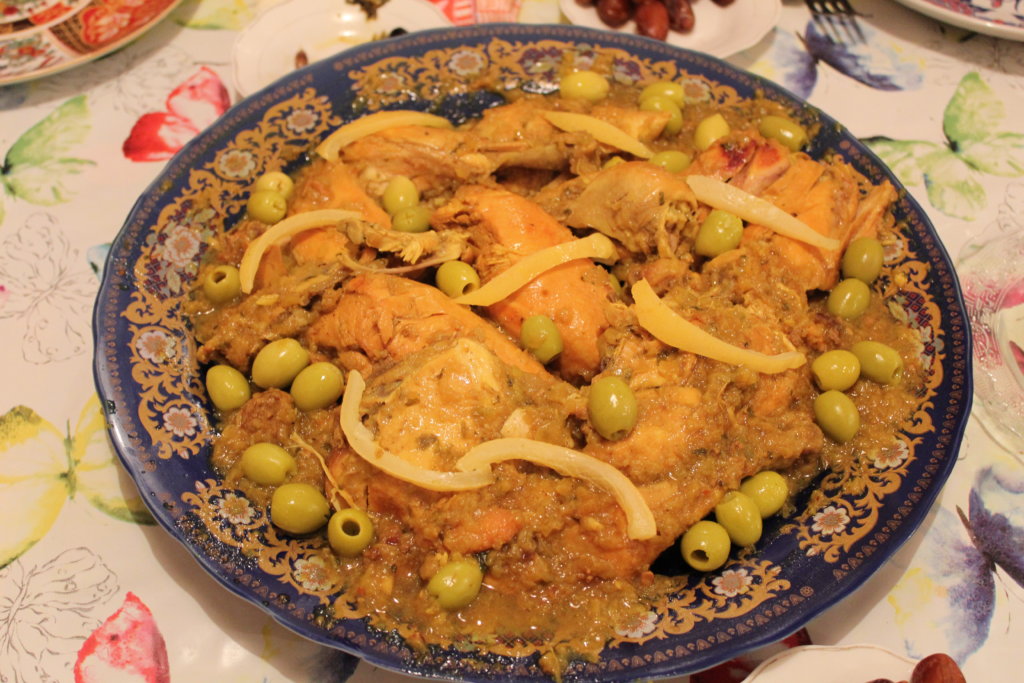
Do a Self-Guided Walking Tour in Rabat
Morocco’s capital, Rabat, is often missed off Morocco itineraries, but that’s a real shame. The city’s architecture is an eclectic mix of ancient and modern. There are beaches and green spaces for relaxing. The kasbah forms its own mini blue city, not as famous or as large as Chefchaouen, but worth a visit nevertheless. Rabat is also home to one of the country’s most visited sites, the mausoleum of Mohammed V. The best thing about Rabat, though, is that it can easily be explored in a day. Read my article about the walking tour we did.
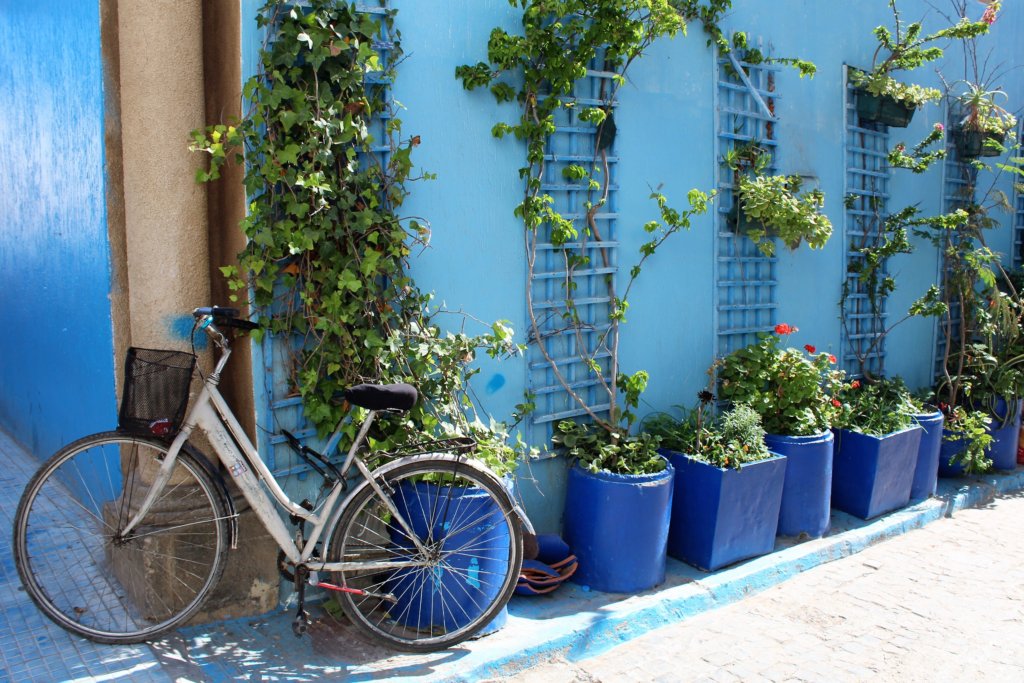
Eat Fish in Essaouira
Essaouira is one of our favourite spots in Morocco. It has long stretches of white sandy beach, a thriving arts, crafts, and café culture, and a very busy fishing harbour. A real treat is to buy fresh fish straight off a boat and then have it cooked for you in a local restaurant.
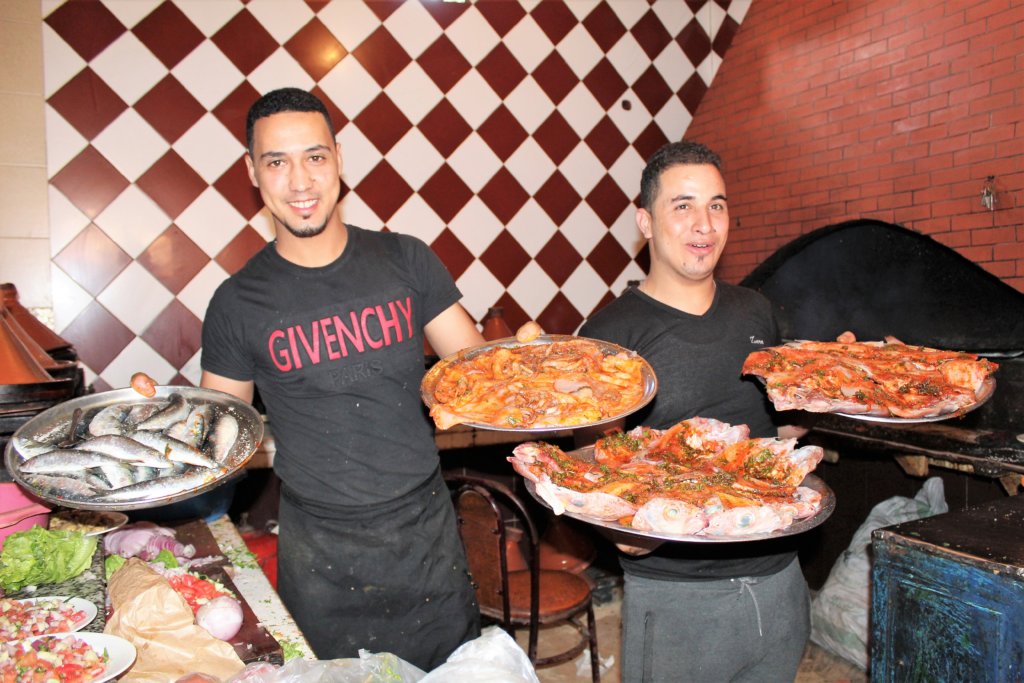
READ ABOUT THE BEST THINGS TO DO IN ESSAOUIRA
Visit Volubilis
The Roman city of Volubilis in Morocco is surprisingly well-preserved and should be included in any itinerary of this diverse nation. Relatively few tourists make it here, so you’re likely to have the site largely to yourself. It’s incredible to see intricate, highly ornate, mosaic floors still in their original location. Hire an official guide at the entrance so that you don’t miss any of the fascinating details about what you’re seeing.
Read my full account of our visit to Volubilis here.
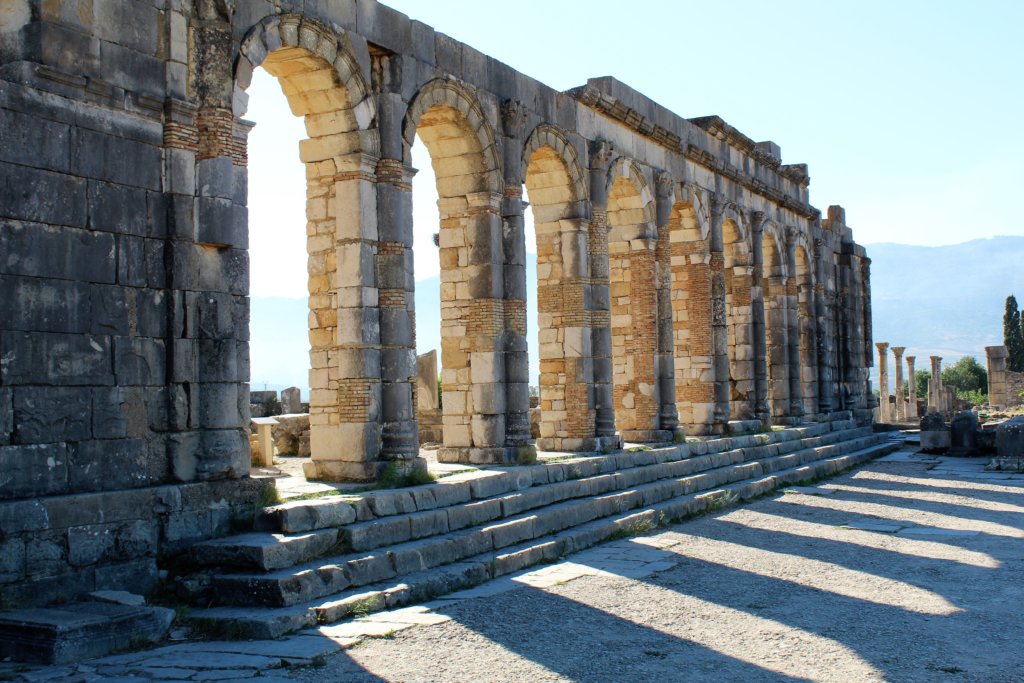
Take a Tour
Whilst it’s perfectly possible to explore Morocco independently, why not join a tour and let someone else sort out the logistics? It’s a great idea, especially if time is limited. Whenever we visit a new destination, we book a tour with a local guide. There’s no better way to get under the skin of a place! We use Viator and Get Your Guide when we want to uncover interesting things to do in a new country. They’re easy to use and book with, and we’ve had some amazing experiences with them.
Check out these options:
Read more about Morocco
Check out my Morocco colouring books!
Unlike most colouring books on the market, mine, suitable for both adults and older children, are full of line images created from photos I have taken on my travels. This means that they are highly detailed. They are not line drawings where you can colour between every line. The pictures invite you to be creative. Apply a colour wash with watercolour. Use coloured pencils to create texture. Blend colours together. Add detail with a fine ink pen. The choice is yours! Create your own work of art! When you’re happy, remove it from the book. Stick it on the fridge as a reminder of a place you’ve already been to or somewhere that’s on your bucket list. You could even get it framed. Display it on the wall for people to admire.
If you like what you’ve read, PIN IT!!
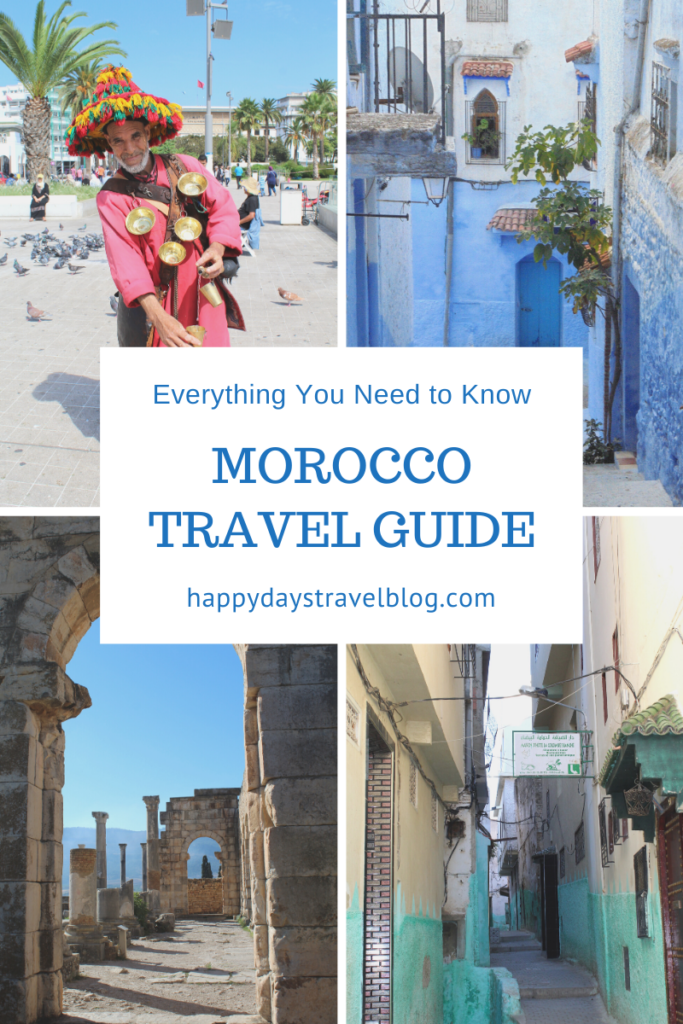
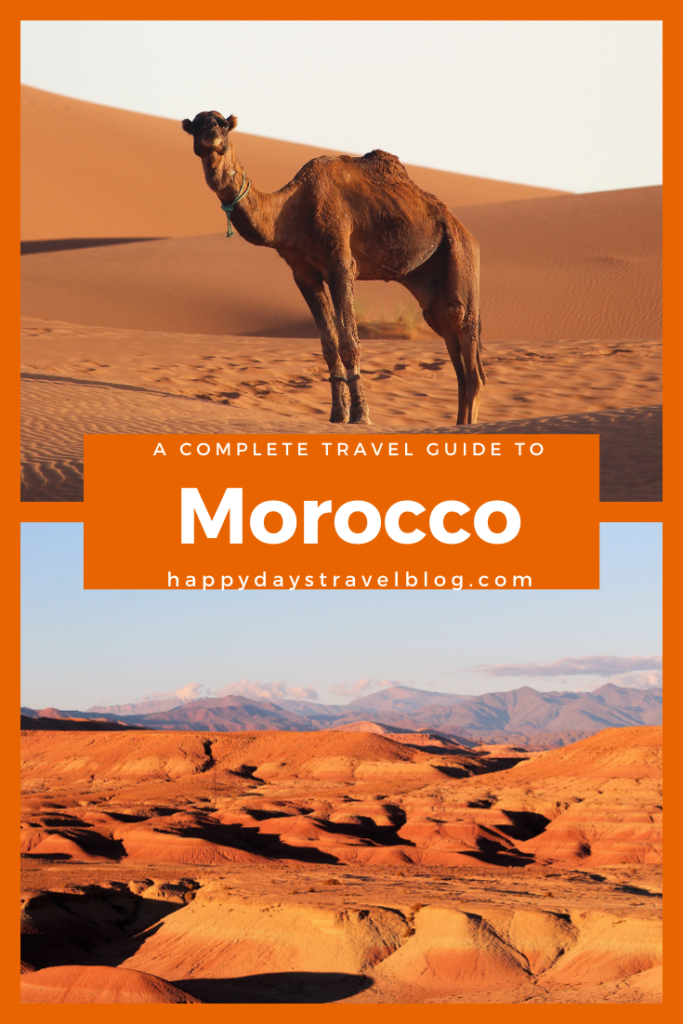
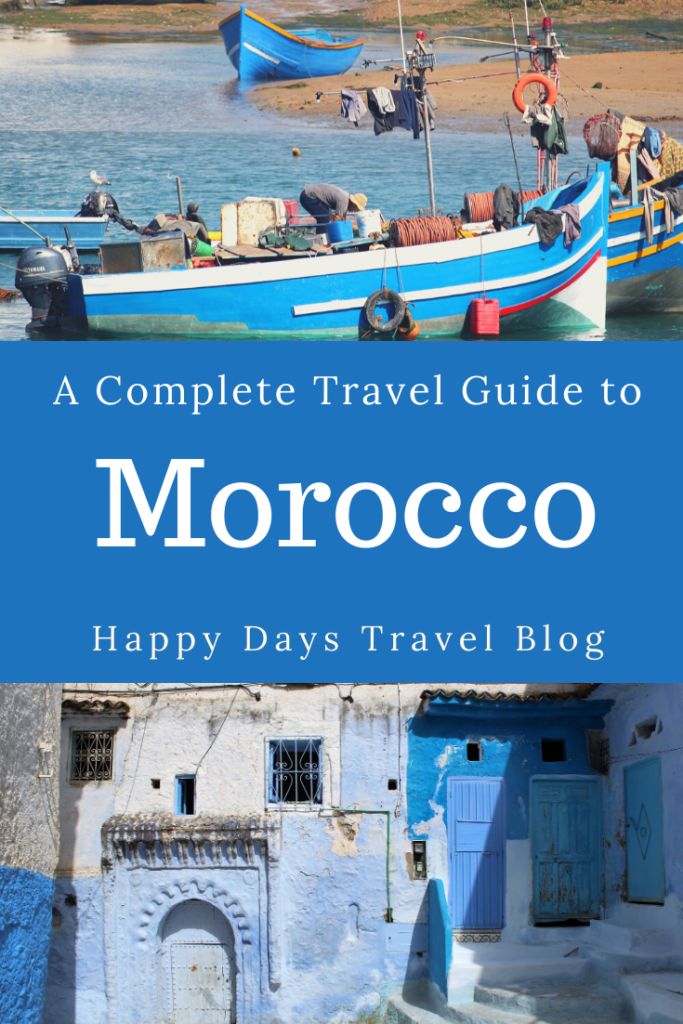
When you are next travelling, please use these links!
Next time you’re planning a trip, please use these links when making your bookings. These are the companies we use. It won’t cost you any extra, but we will earn a few pennies to help keep Happy Days Travel Blog going. Thank you!!
- Book your travel insurance with World Nomads (Never leave home without protecting yourself, your trip and your belongings!)
- Book your flight with Skyscanner
- Book your accommodation with Booking.com
- Book a tour with Tour Radar or Intrepid Travel
- Book city tours and activities with Urban Adventures or Get Your Guide
Disclosure: This post contains affiliate links. If you click through for more information, or to make a purchase, it may result in a small commission coming my way. Please note that there is no extra cost to you associated with this. Thank you so much for supporting my site.
Join our mailing list

Sign up to receive our monthly newsletter. Keep up with what we're doing and be the first to receive special offers and insider tips.

